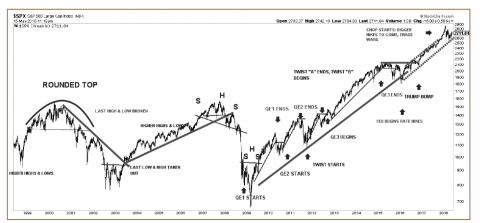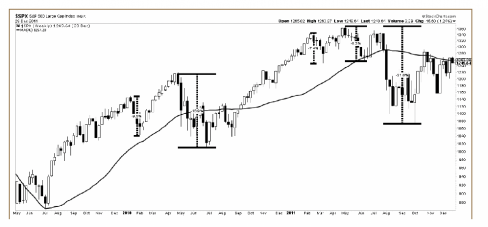Stock Market Musings
 Here’s a 20-year ‘big picture” chart that I have made annotations on concerning market trends and corrections. It’s interesting to note that recent corrections —like we saw in 2010, 2011, and 2016— were usually driven by Federal Reserve policy and related news. Interestingly, corrections of any significance since the 2009 market bottom have NOT been driven by terrorist acts, political events, or international catastrophes (manmade or natural). We have seen our share of tsunamis, flooding, hurricanes, terrorist acts, Occupy movements, country debt defaults or near defaults, nuclear bomb threats etc. None of these inspired a correction of much significance. It has been the Fed, and the fear of (or actuality of) its surrounding decisions, who have moved the markets. Fear of unplugging the stimulus drug drove markets to pull back—not world events. And that is what we have right now—a new Fed regime, and a new hawkish stance to raise rates. The drug is being unplugged.
Here’s a 20-year ‘big picture” chart that I have made annotations on concerning market trends and corrections. It’s interesting to note that recent corrections —like we saw in 2010, 2011, and 2016— were usually driven by Federal Reserve policy and related news. Interestingly, corrections of any significance since the 2009 market bottom have NOT been driven by terrorist acts, political events, or international catastrophes (manmade or natural). We have seen our share of tsunamis, flooding, hurricanes, terrorist acts, Occupy movements, country debt defaults or near defaults, nuclear bomb threats etc. None of these inspired a correction of much significance. It has been the Fed, and the fear of (or actuality of) its surrounding decisions, who have moved the markets. Fear of unplugging the stimulus drug drove markets to pull back—not world events. And that is what we have right now—a new Fed regime, and a new hawkish stance to raise rates. The drug is being unplugged.
So—we have the “Hawkish Fed” factor in place that has, in recent history, inspired the market to correct. What about the timing of such a correction? More importantly - can chart patterns tell us anything about when a significant (20% +) correction will occur?
Bear market corrections start off with some “chop”
The second chart shows us both the 2010 and 2011 corrections. 2010’s correction was some 17% peak to trough, and it occurred that summer. The 2011 correction was a hair under 22% peak to trough, and it occurred over the summer as well, although most of the damage was carried out into the fall. Both occurred during a time of uncertainty surrounding US Federal Reserve policy and in 2011, to a lesser extent, the debt fears surrounding the “PHIG’s (Portugal, Hungary, Italy, and Greece).


It is my opinion that we are currently in the “chop” stage that will lead us into a more significant bear market. My view is NOT for a biggie (i.e. a 50% meltdown) like the 2001 or 2008 bear. I’m in the 20-25% bear market camp. With that in mind – let’s look at the price patterns that proceeded 2011. For the record, 2011 was the closest to a “real” bear market correction since the 2009 bottom. For example – 2010 only saw a 17% selloff and 2016 only experienced a 12% peak-trough selloff, while we saw a 22% peak-trough selloff in the summer of 2011.
Note that in 2010, there was an early corrective “setup” move of 9.5% in early February, a rally, and finally the greater 17% pullback that summer. This was darned close to a “bear market correction” of 20%, making it worthy of noting despite its failure to enter into the “20%” club.
Similarly, 2011 saw a 7.5% early corrective pullback in February, followed by a rally. Only this time, that rally was followed up by another “setup” correction of over 8% in May. The market rallied, and finally pulled back over the summer by 22% – official bear market territory.
Subsequent rallies after each of these “setup” corrections in both 2010 and 2011 fooled market participants into buying high again. The pattern was for the markets to see some interim volatility before the real storm hit.
This year, as in 2010 and 2011, February provided the market with a nice correction this time of about 10%. As had happened in those prior correction years, markets rallied back in early March, although not to prior highs. Then, in late March / early April, we saw another correction right back down to the February lows. The setup was very similar to that of the lead up to the bear market in 2011. Evidence is mounting that this summer may experience a stronger correction than what we’ve seen so far this year, similar to the 22% pullback seen in the summer of 2011.
Where does one hide during a bear market correction? Well, for longer termed investors, you can probably ignore a 20% pullback. If you own good quality stocks, they will recover with the markets and you will likely be no worse for wear. However, if you are a little squeamish when it comes to watching the value of your portfolio fall by such a large percentage, you can always raise cash in the spring. This strategy corresponds with the price patterns I note above. It’s also in line with the seasonal “Sell in May and go away” strategy outlined by analysts like Don & Jon Vialoux, and Brooke Thackray. I tend to focus on selling the higher beta (i.e. higher volatility) stocks within our model portfolios at ValueTrend. There can also be a case for holding some exposure to US dollars and US treasury bonds during a bear market. I recently published a blog entitled “What to hold when stocks fall” that looked at a 30 year pattern on the stock markets vs. the US dollar, the US long bond, and gold. Here is the link: http://www.valuetrend.ca/what-to-hold-when-stocks-fall/
What I found was that of these three stock market “hedges”, only the dollar and the long bond offered investors a consistent hedge (i.e. a negatively correlated asset to the stock market) during significant market pullbacks. Gold, contrary to popular belief, has not a reliable hedge against stock market losses over the past 30 years.
Whatever you choose to do surrounding any summer gyrations this year, you might take heart in knowing that the longer termed cycles for bull, and bear markets suggest a continuation of the current major bull market. Since the Great Depression, there have been two major bull markets (1930 – 1965, and 1982 - 2000). The first cyclical bull market was over 3 decades long, and the second was almost 2 decades in length. We are well under one decade into the most recent bull market cycle. Given that fact, I’d expect there to be many more years of upside, interim pullbacks aside, before the current major bull market cycle ends.
Keith Richards, Portfolio Manager, can be contacted at krichards@valuetrend.ca.
Keith is on BNN Televisions MarketCall Wed. June 6th at 6:00 pm and Monday July 9th at 12:00 noon.
Keith appears regularly on BNN MarketCall to answer viewer questions on the technical analysis of stock trends, and to provide unique insights on the factors of technical analysis used in successful investment management.
If you have questions about the technical analysis of stock trends for individual stocks, be sure to phone in with your questions for Keith during these shows.
Call Toll-Free 1-855-326-6266
Or email your questions ahead of time (specify they are for Keith) to marketcall@bnn.ca
Keith Richards, Portfolio Manager, can be contacted at krichards@valuetrend.ca. He may hold positions in the securities mentioned. Worldsource Securities Inc., sponsoring investment dealer of Keith Richards and member of the Canadian Investor Protection Fund and of the Investment Industry Regulatory Organization of Canada. The information provided is general in nature and does not represent investment advice. It is subject to change without notice and is based on the perspectives and opinions of the writer only and not necessarily those of Worldsource Securities Inc. It may also contain projections or other “forward-looking statements.” There is significant risk that forward looking statements will not prove to be accurate and actual results, performance, or achievements could differ materially from any future results, performance, or achievements that may be expressed or implied by such forward-looking statements and you will not unduly rely on such forward-looking statements. Every effort has been made to compile this material from reliable sources; however, no warranty can be made as to its accuracy or completeness. Before acting on any of the above, please consult an appropriate professional regarding your particular circumstances.

